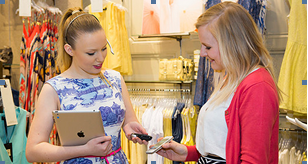The mobile influence

Why branded mobile applications are a powerful marketing tool
How many hours a day do you have your smartphone in your hand, in your pocket or bag?
I’m sitting at my desk with my iPhone right next to my laptop, ready to promptly react should I receive a text, Facebook notification, Twitter mention, push notification or even a phone call.

I expect that most people reading this blog article can relate to this. Our smartphones are convenience, communication, knowledge and entertainment bundled into a sleek package. We’re a population devoted to our devices.
Considering that our smartphones are always with us and always on, this is too good an opportunity for retailers to miss out on. This blog article looks at how mobile commerce and mobile applications, in particular, are fragmenting traditional purchasing patterns and changing consumer behaviour.
‘Foot-in-the-door’
In the UK, 31% of smartphone users have purchased a product or service using their smartphone, and 24% expect to make more mobile purchases in the future (Google: Our Mobile Planet 2012).
Purchases on mobile devices can either be made through a brand’s mobile-optimised website or, if they have one, their mobile application. Big brands such as ASOS, M&S and Amazon are launching into the mobile commerce channel by offering their customers a free mobile application. The app enables users to effortlessly browse products and make purchases whilst on-the-go.
This is a compliance tactic, known by social psychologists and marketers as the ‘foot-in-the-door’ technique. By downloading a company’s free application, a consumer has made a small commitment to the brand. This makes it likely that the consumer will make a purchase from the retailer in the future. At a psychological level, the unconscious mind strives for consistency in our behaviour. If a company can get their customers to download their branded app, they are in a strong position.
A study of nearly 1000 Smartphone owners in the U.S. found that 40.4% of consumers buy more of a retailer’s product if they have their mobile application downloaded onto their own device. (ABI Research)
This isn’t surprising. The small commitment of downloading a brand’s application is significant in terms of a customer’s future buying behaviour. The success of this tactic, however, does depend on how satisfied the consumer is with the user-experience of the mobile application. Brands need to ensure that their apps enable the user to get a feel for the products; this is especially something for fashion brands to take into serious consideration when developing a mobile strategy.
‘Foot-in-the-store’
The influence of mobile applications goes beyond just mobile commerce. Our mobile best-friends are also influencing our purchases whilst we shop in physical stores.
Consumers that use a retailer’s branded app are 21% more likely to make a purchase in store than those who don’t. This is because brands can use their mobile applications to provide a tailored shopping experience for the consumer, which helps them to make their buying decision more swiftly (Deloitte, 2012).
According to a report by Deloitte, Mobile is expected to influence 17-21% of in-store retail sales by 2016. Brands are effectively enticing customers into their stores through their mobile applications. For example, Marks and Spencers recently launched their app which features a QR scanner. This allows customers to scan the barcodes of M&S products in store to reveal more information, look up alternative colours and sizes, or add products to a wishlist. This is multichannel marketing at its best.
Why do these techniques work?
Branded Mobile applications propel the buyer readiness process. The classic model of buyer-readiness is shown below, and attempts to explain the stages a consumer goes through before making a purchase decision. The four stages are Awareness, Interest, Desire and Action.
Although when a company has a branded application, they can essentially bypass the first two stages. Awareness and interest in the brand is already demonstrated by the consumer downloading the app. As we saw earlier, the brand has their foot in the door.
For the consumer to actually make a purchase, the brand needs to stimulate the customer’s desire. For a mobile commerce purchase, this may be done by sending a push notification to their app-users containing ‘call to action’ such as the screenshots shown below. To stimulate an in-store purchase, the brand can entice the customer into their store by offering engaging in-store mobile content such as that offered by M&S.
In summary, the key to mobile commerce success lies in the fact that we are devoted to our devices and this is only set to increase over the next few years. Downloading an application shows a commitment to a brand, which can then be leveraged into purchasing behaviour. This makes branded mobile applications an extremely powerful marketing tool. All businesses, large and small, need to develop a mobile marketing strategy to stay ahead as the mobile game is on and it’s moving forward fast.
Michael Langguth
Co-Founder of Poq
References
ABI Research. (n.d.). Retrieved from here
Deloitte. (2012).The Mobile Influence Factor. Retrieved from here
Google: Our Mobile Planet 2012. (n.d.). Our Mobile Planet. Retrieved from here
Additional point:
Google’s Our Mobile Planet Initiative is an incredibly useful tool for understanding mobile adoption and use around the world . I used it a lot for this article, check it out.






